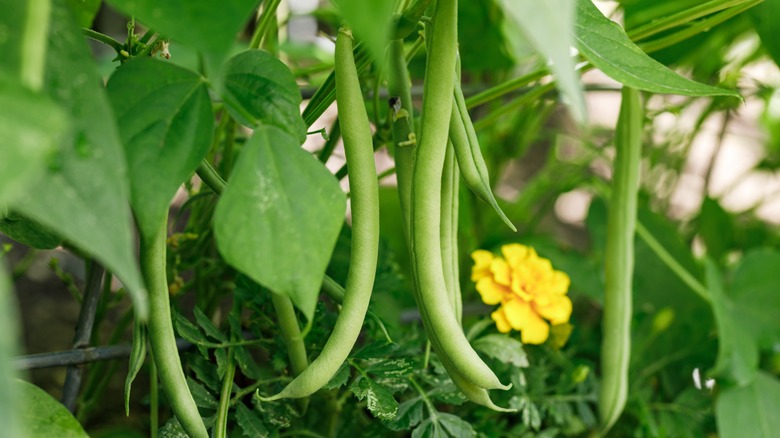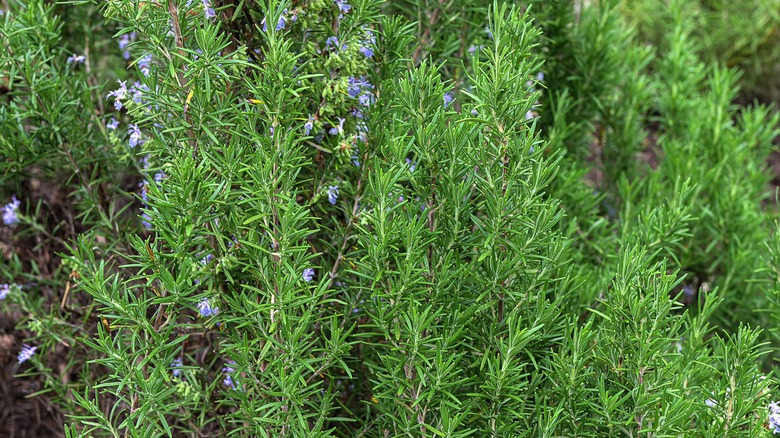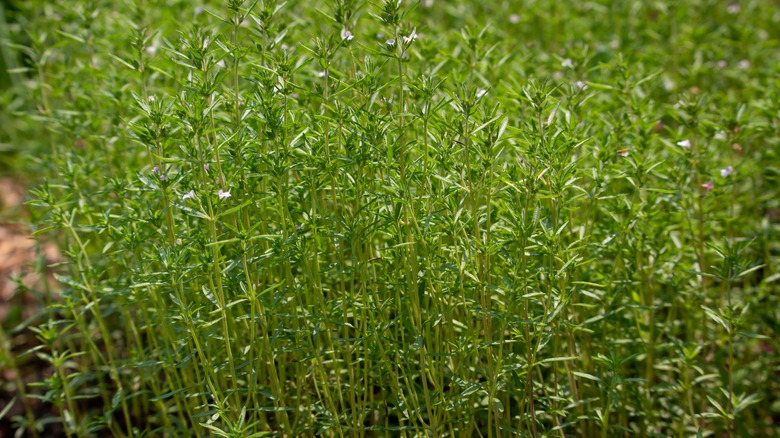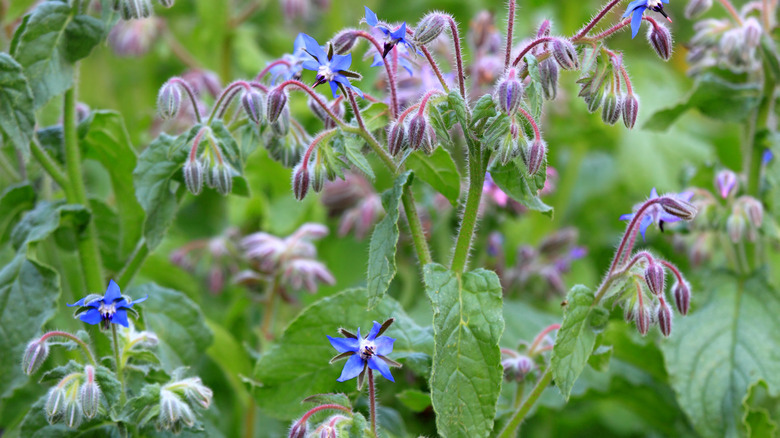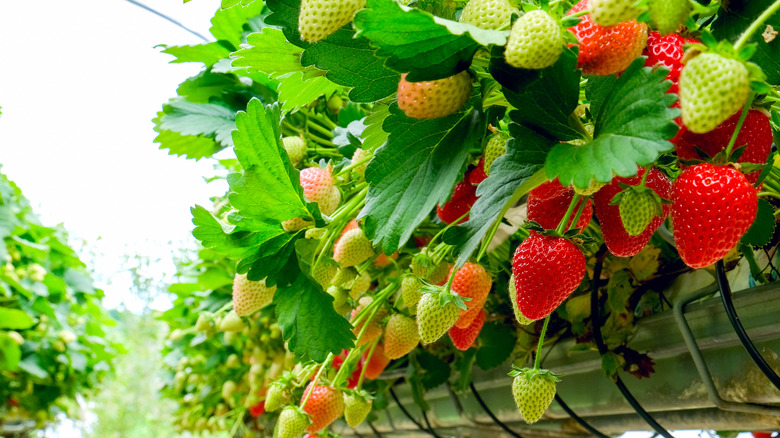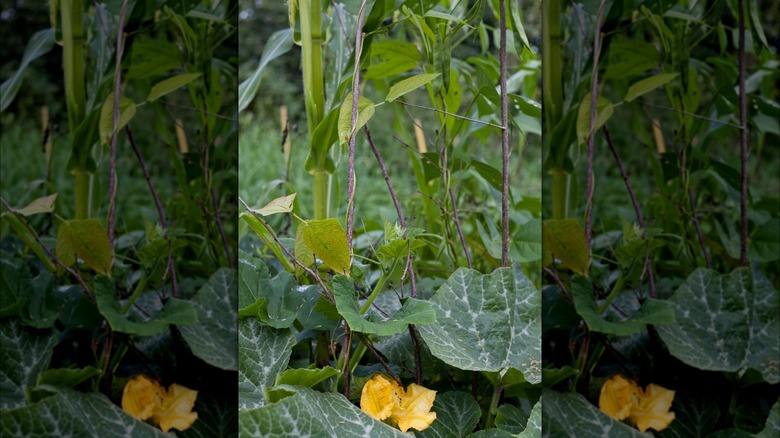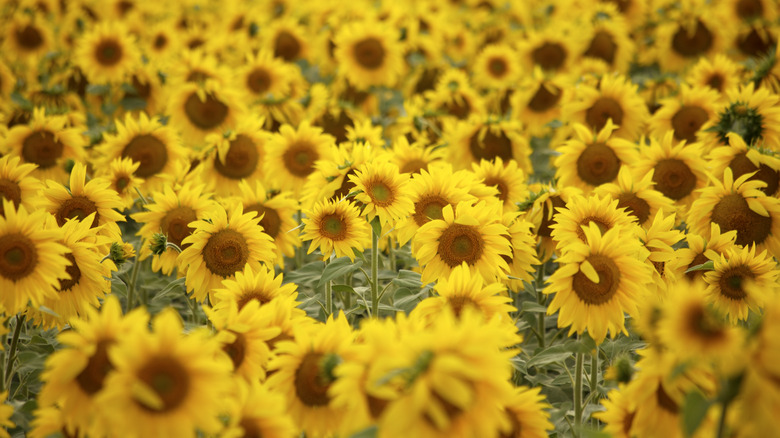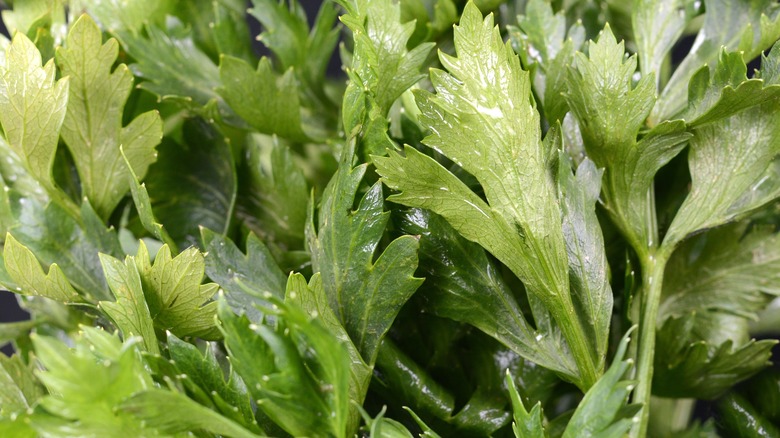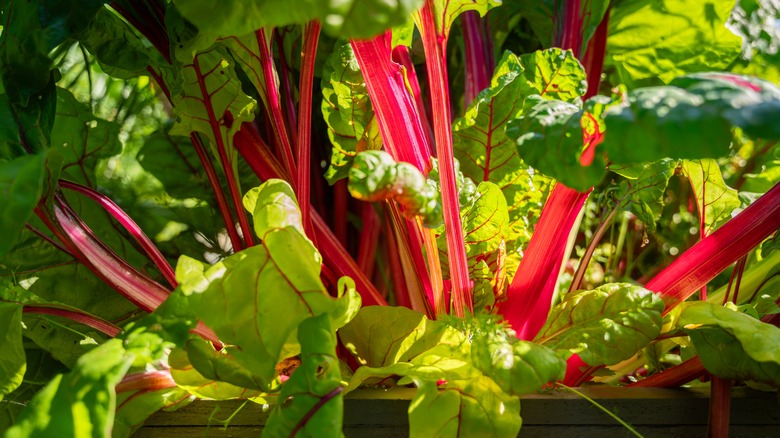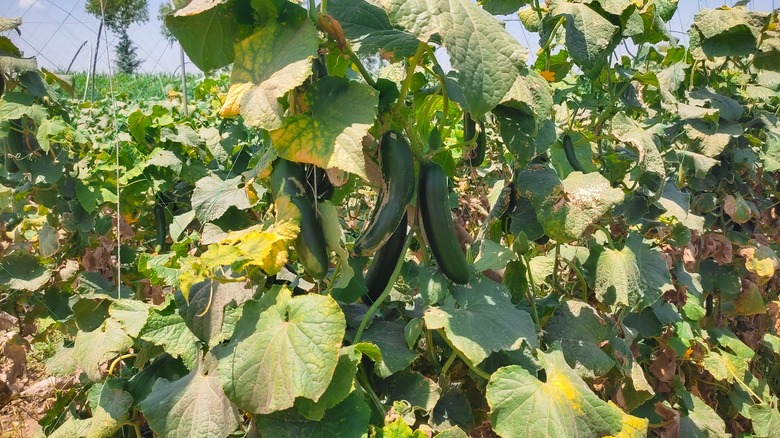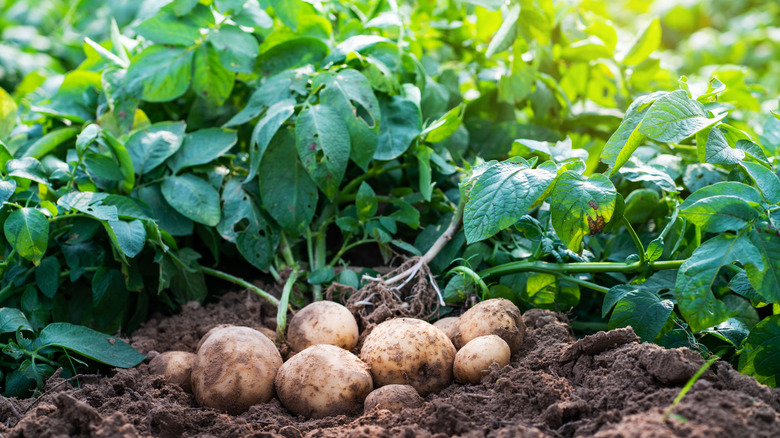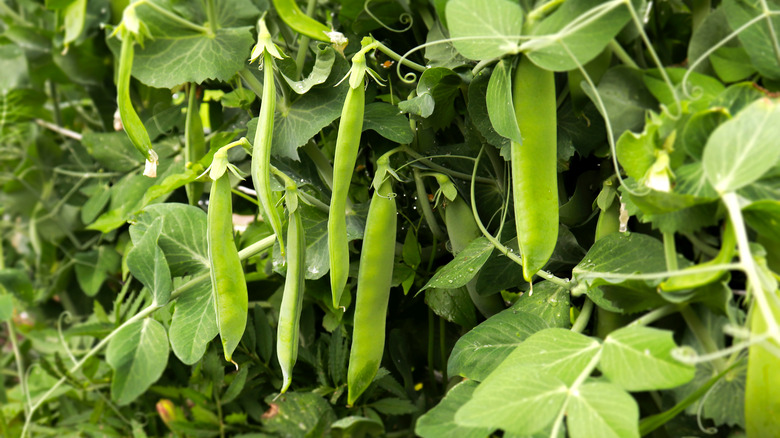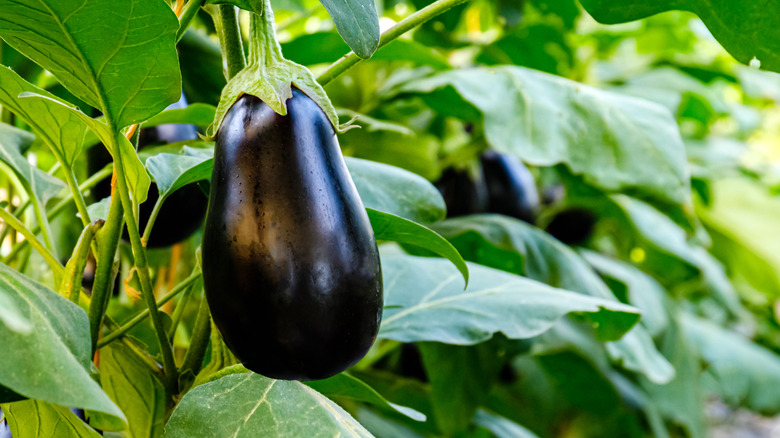Plants & Veggies That Will Thrive Alongside Green Beans In The Garden
Recollections of your parents pushing you to eat green beans or the playground ditty, "beans, beans, the musical fruit," may have you marveling at your planting choices. But when nutrition (and Thanksgiving's customary casserole) is at stake, planting green beans seems like a fated necessity. However, your garden's gastronomic fête doesn't have to stop at the flatulent crop — there's only so much one can consume, after all. 10 bean plants can keep an individual sated, but if your heart is set upon pickling and canning the flavorful veggie, or if you anticipate some plants to perish at your brown thumbs, grow 15 of them.
But then, the ripe question follows: What else can thrive alongside green beans? Most popular veggies can, provided your USDA zone, growth conditions, and personal preferences sync. Cucumbers and eggplants are prime examples, for they flourish in the same conditions as green beans. Growth habits, as in whether the plants stay short (coined "bush beans") or scale a support to grow tall (called "pole beans"), matter too. For instance, corn or sunflowers serve as natural trellises for pole beans. Similarly, potatoes and rosemary fit the (albeit imperfect) "companion planting" criteria by dismissing the pests bullying your beans with variable success across locations. However, you should never grow onions, alliums, gladiolas, garlic, chives, kohlrabi, wormwood, and hot peppers with beans, as they inhibit growth. With that clarified, let's dive into the list of good companions for beans.
Rosemary wards off pests for good
Armed with a spicy fragrance, it's no surprise rosemary understands the art of keeping pests far away, including slugs, snails, carrot flies, cabbage moths, and deer. However, what makes it worthy of being green beans' companion is its knack for driving out Mexican bean beetles. The insect equivalent of a juicer, these grubs flake off and mangle the leafy fibers for the sap, discarding the rest. While the bean plants can bear losing around 1/5 of their foliage, anything more affects their fruiting and growth adversely. Rosemary's presence staves off such dangers, albeit to a limited extent.
Like snap beans (another name for green beans), rosemary plants require over six hours of sunlight and slightly acidic, well-draining soils. However, they are hardy only in USDA zones 8 to 10. Moreover, given their poor germination rate (approximating 15%), you must start them with cuttings. When not battling pesky critters, rosemary turns your yard and garden into a bird haven by attracting hummingbirds and American goldfinches to its lipped lavender blooms and seeds. Don't forget to prune the shrub (significantly!) during the summer, lest it overshadow your bush beans, since rosemary can grow over 4 feet tall!
Summer savory makes the beans appetizing
When taste is foremost, think of summer savory. Appreciated by gourmets for its refined pepper flavor, which contrasts deeply with the hard-hitting notes of its winter counterpart, summer savory is often found gracing bean soups. However, this partnership doesn't have to wait for the cooking pot. Instead, it can start right off the bat in the garden bed. While sharing space, the culinary herb infuses green beans with its characteristic flavor, raising their palatability. It also doubles up as the beans' bodyguard by repelling Mexican bean beetles, a major scourge that leaves no stone unturned in eating the plants inside out and skeletonizing them.
Moreover, summer savory is a breeze to grow, demanding the same cultural conditions as beans. So, when the frost season is long past, transplant its seedlings in the sunniest part of your garden in zones 2 through 11. Although it favors alkaline soil, savory adapts to other mediums, so long as they drain well. Ideally, you should harvest its leaves before the plant buds out in the summer to stimulate new foliage growth. But if you wish to enjoy bees, allow the plant to display its aromatic lilac flowers. Since we don't need many savory plants (four cuts it for cooking, but may need more for preservation), use them to border the rows of beans. That way, the 3-feet-wide spreaders can earn some sprawling bandwidth.
Borage adds visual drama with its gorgeous, pollinator-friendly blooms
Often featured on the lists of herbs that pair well with strawberries, tomatoes, and squash, because of their pest-repellent properties, borage plants, or starflowers, pair well with green beans for a different reason. While their five-petaled, blue summer blooms are sure to dial up your garden's visual appeal, especially when juxtaposed against the staid runner beans, they pull in a blaze of bees and pollinators, too, such as hoverflies. This is important because the broods of hoverflies feed on blackflies or bean aphids — the tiny, greenish-black, sap-sucking insects responsible for reduced pod formation and stunted growth of bean plants.
Besides, borage enriches the soil with minerals, further making a case for growing it in infertile gardens. In fact, when the annual dies back in its adaptive zones of 2 to 11, it can be readily used as mulch for other shrubbery, or added to the compost pile. However, keep your furry companions from nibbling its foliage. Grow borage in full sun and space it at least 12 inches apart, as it needs room to grow. Or, thin it regularly to contain its spread.
Strawberries enjoy the shade and protection beans provide
Those with garden beds sitting on the hotter side of the spectrum, as in eight hours of the sun on full blast, might want to explore strawberries as companions for bush beans. Growing no taller than 12 inches, these perennial edibles appreciate the mild shading of their twice-as-large mates — can't blame them for wanting a short break from the blazing ball of fire, right? There's plenty of anecdotal evidence of home gardeners obtaining spectacular results by combining strawberries with purple beans (yes, the name's a misnomer; green beans can be amethyst or yellow).
To formalize this union, plant the bush beans as borders around the strawberry plants. As this design masks the exquisite, juicy berries, you won't have to resort to using tips and tricks to prevent birds from munching on your garden fruit. However, be mindful of the spacing, as some varieties — June-bearing ones in particular — are quick to overcrowd the space with their runners. If you're up for an experiment, throw a few borage plants in, too. They improve the soil's mineral content while attracting pollination-aiding bees. Robust in USDA zones 5 through 9, you might have to ditch the idea if your bed has seen the nightshade family, such as eggplants, potatoes, or tomatoes, in the preceding four years.
Call forth the Three Sisters: pole beans, corn, and squash
When in doubt, defer to the Native Americans for their nuggets of wisdom. For centuries, they've been growing pole beans, corn, and squash together in their yards — known as the Three Sisters gardening method — as an imaginative, yet scientifically rigorous, grouping. The runner beans treat the nearly 8-feet-tall corn stalks as their trellis for their profuse growth. Contrarily, corn benefits from the legumes' propensity to fix atmospheric nitrogen, although most of it becomes bio-available only after the bean plants have died back and worked into the ground. In contrast, the third wheel, or squash, behaves like mulch, keeping weeds out with its shade-creating, large-leaved canopy. It also keeps the soil cool and moist for the sisters. Pest control might come into the picture with prickly squash preventing raccoons from manifesting their corn-eating fantasies and dissuading squash vine borers from veering closer to the bed with its majestic, undulating beauty.
To create your own Three Sisters model in the garden, start by sowing around four corn seeds per square foot in a raised bed. Once the stalks grow 5 inches, surround them with bean seeds on all sides. When it's past one week, or the snap beans have reached 12 inches in height, bring out and place the squash plants around the bed. Remember, squash is winter hardy only in zones 5 to 10, so cold climate dwellers will have to limit themselves to the corn-beans pairing.
Sunflowers and pole beans support each other's weight
Either as a notable addition to the Three Sisters or as a standalone planting choice, sunflowers exhibit top-notch neighborly behavior with pole beans. The reason? They allow the runner beans to clamber along their sturdy stalks, eliminating the need for a lattice. The beans return the favor when flowers grow top-heavy. In addition, sunflowers are heavy feeders, sometimes requiring fertilization every other week. Coupling with nitrogen-fixing legumes enables them to access more nutrients from within the now-enriched soil. This is pertinent during the fall when early-fruiting bean varieties die back, adding nitrogen to the substrate for the sun-basking sunflowers.
Give life to this arrangement by planting the sunflower seeds in early May in full sun and moist soil, while the pole beans wait for the ground to heat up. Let them grow to around 5 inches so that your beans will have ready support to twine along after being seeded. However, remember that wading through the combined bushy growth can become onerous with some pods hiding deep within the foliage. Allow the sunflowers to go to seed to grab the attention of songbirds and specialized bees. They are hardy to USDA zones 6 through 9.
Celery and bush beans love sharing the garden bed
Entailing several traditional medicinal uses, celery has since been reduced to a culinary ingredient. This is in part due to its green stalks adding much-desired crunch and salted flavor to salads and dips. Other times, its roots and green leaves are used to garnish stews and the like. Given that, and their growth requirements, accenting bush beans with celery plants makes ample sense. Besides, their conically arranged serrated leaves complement the green beans' compound foliage beautifully. Moreover, as celery sucks up nutrients, sharing beds with green beans improves its access to nitrogen. While celery plants, like green beans, can grow 2 feet tall, it happens over the course of 80 to 120 days versus the 50 to 60 taken by their companion. This temporary shading helps conserve water, which the moisture-loving celery adores.
Adaptive only in zones 3 to 6, the pollinator attractant can be planted along with beans from mid-May until June (depending on the location). Alternatively, you can grow them successively at a three weeks frequency to prolong your "personal farming" season. Don't go overboard, though, as five plants are all you need for regular cooking. Site celery in full sun.
Chard enhances the green beans' aesthetic
If you relish the taste of spinach, but can't be bothered to meet its never-ending list of demands — the day length and heat sensitivity, foremost — Swiss chard might become yours and your green beans' best friend. They too are winter hardy in zones 2 to 11, are desirous of sunbathing for over six hours, and prosper in well-draining, fertile soils. But if your yard is missing the last essential, site them next to snap beans and let the native legumes' solid partnership with nitrogen-fixing rhizobium bacteria work its magic.
But don't think the chard-bean relationship is one-sided. In addition to the typical green cultivars like "Fordhook Giant" and "Lucullus" that you've come to use in your soups, chards encompass a wide form and color variety. Their red-veined forms like "Ruby Red" and "Rhubarb," or the five-colored variety "Neon Lights," are gorgeous annuals that add ornamental beauty to your bean beds (the salads will look far more appetizing, too!). However, Swiss chard must be planted four weeks ahead of the expected last frost, rather than after frost, as is the case for green beans. Also, they should be planted densely to suppress weeds, but can be thinned later once the seedlings grow three to four leaves.
Cucumbers and beans are a space-saving combo
Matching green beans' cultural requirements from fruit to root, cucumbers are probably the easiest companions to plan for — and sometimes, that's a good enough reason to team different plants together. However, the way you team them up can make all the difference between being imaginative and space-saving or playing safe and conventional. So, while cucumbers make a good squad with bush beans, such coupling necessitates that you leave ample roam space on the ground (upwards of 2 feet on either side). That's because, when untrained, cucumber vines can spread almost 8 feet wide, while topping out at 18 inches. Bush cultivars with really short vines are an exception to this rule.
Alternatively, if you train the cucumbers along with pole beans on a shared trellis or a teepee, it'll both save you space and add a stunning feature to your garden. Not to mention, you get a tall view of all the bees zapping around and quenching their thirst with nectar. Moreover, training vines elevates the fruit, encouraging a straighter, healthy shape. The enhanced airflow reduces disease susceptibility, too. However, watering requirements will increase, as well as the risk of the vines tangling uncontrollably. Cold hardy up to zone 2, transplant both veggies in a sunny site when it's past the frost season, and be prepared to harvest them in under 70 days. Unless you wish to pickle the cucumbers, stick to growing three plants per person.
Potatoes and bush beans protect each other from critters
The humble vegetable that we all can't imagine our lives without (imagine not having French fries!) has apparently much to offer and take from green beans. Assuming equal parts responsibility, potatoes take down Mexican bean beetles, a destructive anomaly in an otherwise beneficial ladybird community, for their green companions. Green beans return in kind by driving out Colorado potato beetles keen on destroying their Irish companion's foliage for their child-rearing purposes. Almanac even proposes that beans can enhance the tubers' size.
So, how does their camaraderie come to fruition? Your best bet is to lace your garden with alternating rows of bush beans and potatoes. But if you can consume the full crop, interspersing beans with the potatoes in their appointed rows will create a more foolhardy defense. Remember, tubers go into the beds earlier (mid-April), while the beans aren't due for planting until mid-May, so make plans accordingly. At home in USDA zones 2 through 11, they share the beans' sensibilities of full sun and rich, good-draining soils.
Peas and beans make easy partners
This pairing is more of a cheat code, as both peas and green beans are stars of nitrogen fixation. Indeed, pea's usage as a cover crop (goes by the name of "Austrian winter pea" in this role) is informed by this property. Also, its numerous varieties proffer diverse combinations. For instance, if you've already invested in a trellis, you can simply wrap their vining varieties with pole beans — picking the fruit would be easy too. Similarly, if you've planted bush beans, you can look for a corresponding pea variety. Densely-packed rows of peas and beans can overpower weeds as well.
The best part, though? They desire similar site conditions — full sun, good drainage, neutral soil pH — as well as the USDA zones of 2 to 11. Truly, behaving like two peas in a pod (green bean, who?). But because peas are a cool-season vegetable, they must be planted as soon as the ground thaws, meaning around mid-April to early-May. You can prolong their season by staggering the plants every two weeks until the baton is shared with and ultimately passed on to green beans. Pea plants max out at 18 inches in height and may benefit from the bean's shade, especially when the temperatures soar over 85 degrees Fahrenheit. Side note: Beans and peas must be terminated before they go to seed to enrich your soil.
Eggplants uptake the nitrogen fixed by beans
Limited in their range up to zone 9, eggplants are another companion worth consideration — more so, if their taste aligns with your palate. Even though they don't tender any major benefits to green beans, save for being a decent partner, the reverse isn't true. For starters, they're a nutrient-hungry group, relying on several bouts of feeding in their short lifetime if their planting medium is particularly lacking. So, being paired with the legumes may offset some of their demands, considering they're planted later in June and the beans have had time to add nitrogen to the soil.
Also, like their nightshade family cousins, eggplants suffer at the mouths of Colorado potato beetles (both adults and larvae), undergoing the worst damage of their lot. Indeed, their fruiting ability is reduced meaningfully once their foliage damage exceeds 15%. But sitting next to green beans improves their chances of survival, as the beans can repel the treacherous potato beetles.
As eggplants are a warm-season annual, they prefer sites exposed to the sun for around eight to 10 hours (with six hours being their baseline requirement). They also favor fine-draining soils with a dash of acidity, with the ideal pH hovering between 5.5 and 6.8. Although edible to bumblebees, these veggies can cause problems for your pets if they snack on their flowers, shoots, or leaves.
